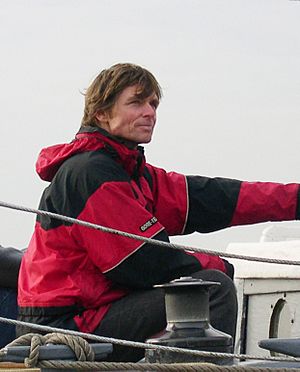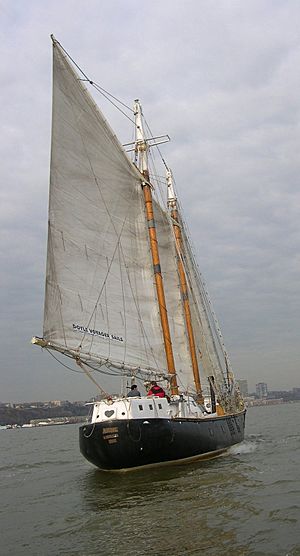Reid Stowe facts for kids
Quick facts for kids
William Reid Stowe
|
|
|---|---|
 |
|
| Born | January 6, 1952 |
| Nationality | American |
| Occupation | Artist and Craftsman, Sailor, Adventurer |
| Known for | Extended voyages with schooner Anne |
William Reid Stowe (born January 6, 1952) is an American artist and mariner, which means he's a skilled sailor. Reid grew up loving sailboats on the East Coast of the United States. He sailed across the Pacific and Atlantic Oceans when he was a teenager and in his early twenties. By the time he was 26, he had already built two of his own sailboats with help from his family and friends.
In 1986, Stowe sailed his schooner, a type of sailboat, named Anne all the way to the cold waters of Antarctica. Later, in 1999, he completed an amazing 194-day journey without stopping or touching land.
His most famous trip was in 2010. It was called 1000 Days at Sea: The Mars Ocean Odyssey. This journey started on April 21, 2007, from Hoboken, New Jersey. Stowe designed and built the Anne himself. It's a large, 70-foot (21.3 m) schooner weighing 60 tons (54,400 kg). The main goal of this trip was to stay on the open ocean for one thousand days without getting new supplies or stopping at any harbor. He also hoped to sail around the world four times, but he completed one trip around the globe.
On June 17, 2010, Stowe sailed the Anne up the Hudson River and docked in New York City. He claimed his total voyage lasted 1,152 days. This could be a record for the longest continuous sea voyage without resupply or stepping on land. When he landed, his family, friends, his girlfriend Soanya Ahmad, and their young son met him. Soanya had been with him for the first part of the journey.
Early Life and Building Boats
Reid Stowe was born on January 6, 1952, near Moses Lake, Washington. He was the oldest of six children. His father was in the United States Air Force, so Reid's family often traveled with him. As a child, Reid lived in Germany for three years and the Philippines for two years. He also lived in several states like Mississippi, Illinois, Arizona, and Virginia.
Even with all the traveling, the family usually spent summers with Reid's grandfather. His grandfather had built a beach cottage near Ocean Isle Beach, North Carolina on the Intracoastal Waterway. Reid's grandfather and uncles often built and fixed parts of the house. They also built small boats for the waterway. During these summers, Reid learned a lot about carpentry. In high school, he and his younger brother, Wave, built fiberglass surfboards. They used workshops their family had in their winter homes to finish their projects after school.
First Ocean Adventures
Reid Stowe first studied art at the University of Arizona, where he learned painting and sculpture. In his late teens, he visited Hawaii in the summer to surf. When he was 19, he met Craige Fostvedt in Hawaii. Craige had bought a small sailboat with his college money. Reid was invited to sail with him through the South Pacific to New Zealand.
Reid needed a passport for this trip, which meant getting his birth certificate. Years later, Stowe said his parents could have easily told him to come back to school. But they sent the certificate, which he saw as a big sign of their support. This trip was Reid's first time sailing on the open ocean, and he fell in love with it.
After his South Pacific journey, Stowe returned to his grandfather's home in Ocean Isle Beach, North Carolina. He spent eight months building a 27 ft (8.23 m) and 1,400 lb (635 kg) catamaran called Tantra. He built it specifically for open ocean sailing.
Crossing the Atlantic
While building Tantra, a Dutchman Reid had met in the South Pacific visited him. This friend convinced Stowe to sail the catamaran across the North Atlantic to the Netherlands. They started their journey in June 1973. After arriving, Reid Stowe continued on a solo trip. This voyage took him to Africa, then across the Atlantic again, and to Brazil and the Amazon River. He returned to the United States in 1976.
Stowe later claimed that Tantra was "the smallest boat to cross the Atlantic Ocean twice." However, a smaller boat had made a round-trip crossing much earlier. In 1880–1881, George P. Thomas and Frederick Norman sailed their 16 ft 7 in (5.05 m) dory Little Western from Gloucester, Massachusetts, to Cowes, England. They stayed in England for almost a year and returned to America the next June.
Building the Anne
After returning to the United States, Stowe started thinking about building a boat perfect for very long voyages. He was very impressed with gaff-rigged schooners. He felt they were the best kind of sailing vessels. In 1976, he moved into his maternal grandfather's beach cottage in North Carolina. With a lot of help from his mother's family, his retired father, and his siblings, Reid Stowe began building a new sailboat.
He designed it like the American gaff-rigged fishing schooners from the late 1800s. The finished design was for a 60-ton (54,400 kg), two-masted gaff-rigged boat. It was 70 ft (21.3 m) long with a 16 ft (4.88 m) beam. Unlike the old schooners, Stowe and his family used Ferralite over steel wire mesh for the hull. The inside was finished with Caribbean hardwood, mostly from wood washed ashore by Hurricane David.
Stowe said the hull was like a sealed steel and fiberglass bottle. Also, electricity for computers and communication gear came from wind, solar, and water motion generators. Stowe, his family, and friends worked on building the boat for 18 months, finishing in 1978. The entire shipyard was on his grandfather's property.
The boat was first named Tantra Schooner. Stowe made it his home. He first sailed it to the Caribbean with his wife at the time, Iris, and their baby daughter, Viva. They finished the inside of the boat while sailing.
Adventures with the Anne
Sailing to Antarctica
The Tantra Schooner was first used for charter trips, where people could rent it. But it was also built for very long voyages. It had space that could be used as a cargo hold when not needed for extra rooms. This meant the Tantra Schooner could carry enough supplies to be self-supporting.
The boat was later renamed the Anne to honor his mother and her family. In 1986, Stowe took the Anne to the Antarctic with a crew of eight. This was his first big test with the boat. For five months, Stowe and his crew sailed around the Antarctic Peninsula and the South Shetland Islands. Stowe sailed into ice packs and said they faced winds up to 110 mph (177 km/h). He recalled a strong gust that blew the boat completely over, but it righted itself.
To fight boredom, the crew used plastic filters to bathe in different colored lights. They also had a "bag of tricks" with scented herbs, spices, stones, and other items. These helped stimulate their senses and reminded them of home.
During this voyage, Stowe started thinking seriously about a very long trip. He planned a "1000-day voyage without touching land or receiving supplies." The goals included testing equipment and seeing how people would do in isolation, similar to a trip to Mars.
Preparing for the Big Voyage
In the fall of 1997, Stowe began using Pier 63 in Chelsea, Manhattan, New York City, as his base. He seriously promoted his one thousand-day voyage, calling it "1000 Days at Sea: The Mars Ocean Odyssey." A news article at the time suggested a launch date of 1999. It took eight more years before Stowe found enough money and media support for the project. During this time, Stowe lived on the Anne and used Pier 63 as his address.
In 2006, a new park was being built along the Hudson River. This forced the marina owner at Pier 63 to move. So, the schooner Anne moved to the 12th St. Pier in Hoboken, New Jersey. This is where Reid eventually started his epic journey.
The Turtle Voyage: A Practice Run
Stowe's practice run for his big voyage happened in 1999. He and his new wife, Laurence Guillem, sailed the South Atlantic Ocean for 194 days on the Anne. Laurence called this trip "The Odyssey of the Sea Turtle." Stowe's idea was to sail a course that looked like a turtle on a GPS map. He said this choice was about not always rushing. He also said the turtle reminded people about endangered species and the environment.
The voyage lasted from June 4 to December 17, 1999. There were no major problems, but some challenges. The Anne's engine broke down near the Verrazano-Narrows Bridge. Old sails made it hard for Stowe to navigate precisely, so the turtle shape wasn't as big or complete as he hoped. They also had a close call with Hurricane Lenny on their way back to New York. Still, he and his sailing partner spent over half a year out of sight of land.
More Attempts
Stowe and Laurence tried another long trip in January 2001. They sailed to Trinidad, but the Anne ran into very bad weather off Bermuda. The ship was knocked over on its side once in high seas, but it righted itself. Laurence injured her jaw in the accident. This was the last big voyage Laurence took with Stowe. She later said, "I love Reid, but he is a fish and I am not."
The 1000-Day Voyage Begins
Stowe and Soanya Ahmad started the 1000-day voyage on April 21, 2007, at 3:00 PM EDT. They left from the 12th St. Pier in Hoboken, New Jersey. About 100 people, including his parents and former wife, Laurence Guillem, watched them leave. The heavily loaded schooner sailed through New York Harbor and into the open ocean that evening.
This departure put into action plans that Stowe had discussed years earlier. He believed that being isolated and confined on a long sea voyage would be similar to a trip to Mars. The name, 1000 Days at Sea: The Mars Ocean Odyssey, and the length of the trip reflected these ideas. The scientific goals, like studying weather and pollution, were not fully met because they lacked the right equipment.
Some unexpected things happened early in the voyage. On April 25, 2007, the schooner sailed near a US Navy missile test off the New Jersey coast. The United States Coast Guard warned them, and they changed course safely. A more serious accident happened on May 6, 2007. The schooner hit a container ship, which badly damaged the Anne's bowsprit (the pole sticking out from the front). However, the hull and the rest of the boat were fine. Stowe was able to make a shorter replacement bowsprit from the less damaged parts. After these events, the boat spent much of late 2007 in the Southern Atlantic. It passed the tip of Africa in mid-December 2007.
Soanya Leaves the Journey
A big event happened on February 22, 2008. Stowe's companion, Soanya Ahmad, decided to leave the voyage. After 306 days on the schooner Anne, Soanya had to get off the boat. It was later discovered she was experiencing morning sickness. She disembarked near Rottnest Island, close to Perth, Western Australia. Members from the Royal Perth Yacht Club, including famous sailor Jon Sanders, met the Anne and helped Soanya leave. She arrived in Perth around 9 PM local time. Soanya said she had been suffering from constant seasickness since November.
Soanya's departure left Stowe alone on the boat. This changed one of the original goals of the voyage: "to leave the land and all support, sail for 1,000 days, non-stop at sea without receiving help..." Mr. Stowe decided to complete the mission by himself. Jon Sanders, who held the record for the longest solo time at sea, was asked if Reid could break his record. Sanders, who helped Soanya leave, said the boat looked strong. He also admitted that Reid Stowe had a lot of patience and time, and it was possible he could break the record.
After leaving the schooner Anne on Day 306, Soanya returned to New York. In July 2008, she gave birth to their son, Darshen. Two years later, the whole family lived aboard the Anne.
Completing the Voyage
On Day 658, Reid Stowe broke the world record for the longest non-stop ocean voyage. This record was previously held by Jon Sanders. This record does not include Nansen's Fram expedition, where the schooner Fram was stuck in ice for almost three years. Its crew was away from land for at least 1067 days.
Reid Stowe and his support team achieved one of their main goals: a person sailing on the open seas without resupply for 1000 days. He also broke the 1067-day record set by the Fram in 1896. January 16, 2010, was the official 1000-day mark. March 24, 2010, equaled the 1067-day mark. After Soanya Ahmad left on Day 306, Reid Stowe also broke the record for the longest solo sea voyage without resupply on Day 964 (December 11, 2009).
Also, as a two-person crew (man and woman), Stowe and Ahmad could claim the longest non-stop voyage by a man and a woman. This record was previously held by Bernard Moitessier and his wife Françoise, who completed a 126-day voyage in 1966.
However, none of the records claimed by Stowe were ever officially recognized. The World Sailing Speed Record Council focuses on speed records. They no longer recognize "human condition" categories, which can be too broad.
Throughout the journey, Stowe stayed in touch with his support team in New York City using an Iridium phone. He used a VHF marine radio for talking to other ships. Volunteers kept a web site updated so the public could follow the voyage. The entire route of the schooner Anne was checked daily by GPS tracking. The company that made the GPS equipment made the tracking data available online.
Until the computers broke down in December 2009, almost daily logs with photos were sent by email using the satellite phone. Soanya and Reid first sent these messages. After Soanya left the schooner, Reid became the only one sending updates.
Reid Stowe saw his son for the first time after landing his 70-foot schooner Anne in New York. He reunited with Soanya Ahmad on Thursday, June 17, 2010. The couple had not seen each other since Soanya had to leave the voyage in February 2008.
See also
- List of circumnavigations
- GPS drawing
- Tania Aebi
- Colin Angus
- Robin Lee Graham
- Roz Savage
- Katie Spotz
- Henk de Velde



